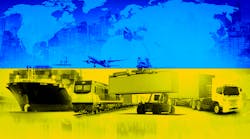How the Invasion of Ukraine Could Impact Already-Weakened Global Supply Chains
As Russia’s invasion of Ukraine continues, and as the country under siege puts all of its power into fighting off the invasion, the impacts are beginning to come into focus. In addition to the steep toll that the invasion is taking on human life, it is also affecting economies, industries and supply chains around the world.
The auto industry is one of several sectors bracing for significant negative impacts of the Russian invasion, which could cut auto production by “millions of vehicles” in 2022, according to CNBC. It says Russian production may feel the greatest “near-term impact” as organizations continue to suspend operations.
The longer the conflict continues, the higher the risk of ripple effects across the automotive industry. “There’s no question. It’s going to ripple. It’s just going to be really dependent on obviously how long this goes on,” LMC Automotive’s Jeff Schuster told CNBC. “The sanctions and trade impact play a big role in that.”
Creating New Supply Problems
CNBC says the invasion is also creating supply problems for parts like wire harnesses, which serve as a vehicle’s wiring system. “The war is also expected to further escalate existing supply limitations of parts such as catalytic converters and semiconductor chips that use materials and gases from the region,” it notes. “The crisis could worsen rising inflation and propel already record-high vehicle prices even higher.”
“The European auto market will feel the effects far more quickly than the U.S. and other markets,” CNBC adds, with European automakers like Audi and Mercedes-Benz already announcing plans to cut production output at plants due to parts disruptions out of Ukraine—specifically, wire harnesses.
For American consumers, one of the most tangible results of the invasion so far has been prices at the gas pump, which haven’t seen this level of increase since mid-2008 (not adjusted for inflation), according to CNBC. As of March 9th, AAA’s daily gas survey was reporting a national average of $4.53 per gallon, up from $3.66 a week prior and $2.80 one year ago. The highest recorded average price as of March 9th was $4.89 per gallon for diesel, AAA reports.
Forecasting is Difficult Right Now
CNBC notes that early forecasts for the reduction in vehicle output resulting from the conflict “vary greatly given the fluidity of the situation,” although it reports that LMC Automotive has already adjusted its forecast to cut 700,000 units of European production.
CNN warned that the crisis may have the most significant impacts on Europe, which depends on Russia for natural gas. “Oil prices have surged worldwide, driving up prices for gasoline and raising the cost outlook for airlines and other industries, such as plastics, that rely on petroleum,” it states.
The conflict may also exacerbate the worldwide computer chip shortage, and mainly because Russia supplies 40% of the world’s palladium, a key resource to manufacture semiconductors. And, Ukraine produces 70% of the world’s neon, a gas used in making computer chips. Should the military conflict persist, these and other factors will only add to the current chip crisis.
The Ripple Effects Continue
With 374,000 businesses around the global—90% of which are U.S.-based—relying in some way on Russian suppliers, the longer the invasion and the crisis it has created persist, the bigger the impacts will be on the world’s supply chains. In its new Russian-Ukraine Crisis report, Dun & Bradstreet outlines some of the biggest problem areas to watch in the coming weeks.
“Russia and Ukraine are among the largest commodity-exporting nations in the world controlling crucial natural gas, oil, metals, and agri-commodities on a global scale, and also serve as vital lifelines for the European economy,” D&B says. “If this crisis is prolonged, it could force significant implications for Europe’s energy supply, as well as present food security issues for many countries.”
If the conflict continues, D&B says that the availability of these and other critical raw materials would be jeopardized and transportation costs would increase. “In addition, businesses worldwide may experience further supply chain bottlenecks and increased pricing pressures,” it adds.
D&B says this is “yet another reminder of the interconnectedness that comes with globalization and our reliance on each other as contributors to the global supply chain.” It says there are currently 14,745 Tier 1 and 7.6 million Tier 2 supplier relationships with Russian entities globally. “As a result,” it adds, “we are seeing the ripple effects of U.S., UK, and EU sanctions on Russian companies – further crippling an already weakened global supply chain.”
This article appeared in Source Today.
